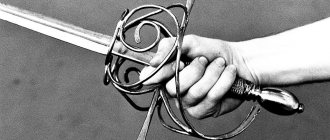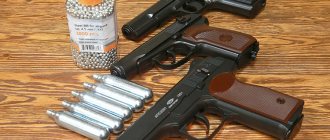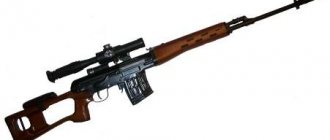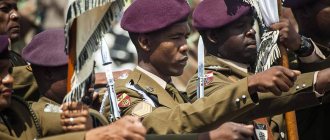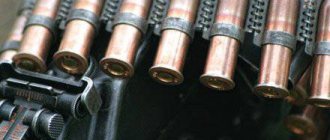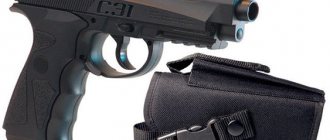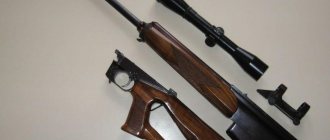Many people often do not understand how a traumatic pistol differs from a combat pistol, and we will try to figure it out. The operating principle of both types of weapons is the same. Although there are significant differences. The main feature is the barrel system of the traumatic pistol. Inside it there is a metal protrusion (pin), which closes the hole by 20-30%. This blocks the passage of cartridges that have a reinforced charge or a solid core. There is also a type of restriction that is made by mechanically pressing the outer surface of the barrel. Don't panic, because a rubber bullet can easily overcome these obstacles. However, this design is not entirely perfect. If the cartridge is defective and does not contain enough powder, then the rubber ball may become stuck on the way out of the barrel. When you try to fire again, often the next bullet can simply destroy the barrel of a traumatic pistol. This can be prevented. The ball, which is stuck in the barrel, increases the gas pressure from the gunpowder and thereby causes a rapid recoil of the bolt and greater recoil. We strongly recommend that you monitor all kinds of unusual situations in the operation of such weapons.
Traumatic pistols have another difference. Their automatic equipment is made of special materials that are not designed for heavy loads, which, in turn, will not make it possible to convert the pistol into a combat one.
Definition of traumatic weapon
Weapons intended for defense and forcing someone to give up attack are called traumatic. In legislation, this type of weapon is called OOOP - firearms of limited destruction.
This includes:
- smoothbore hunting rifle loaded with shot;
- pistol or revolver with muzzle energy less than 50-70 Joules;
- gas pistol;
- light noise;
- signal pistol;
- weapons for shooting sports.
An air gun does not fall under the traumatic category.
Design differences
The projectile-ball flies out of the pneumatic gun under the influence of pressurized gas or air. The shot provokes the expansion of the gas, and it transfers kinetic energy to the ball, setting it in motion.
The following types of air guns are popular:
- spring-piston - simple, inexpensive and reliable models that do not have a reservoir for storing compressed air. The air cylinder is connected directly to the barrel;
- compression – there is a specially designed closed compartment for pumping gas. To fire, you need to turn a lever that moves a piston connected to a gas tank. Such models require more careful care;
- with pre-pumping (PCP) - provide better accuracy. Structurally similar to compression ones, but without a gas pumping system. The gas tank can be removable;
- Gas - characterized by high power and accuracy, but are ineffective at sub-zero temperatures.
Traumatic weapons often copy firearms, for example, revolvers, but there are models with a unique design. The energy source here is powder gases, and instead of balls there are rubber bullets with a metal core. They are often the same caliber as live ammunition. Power limitation - up to 91 J.
Legislative norms
Any citizen over 21 years of age can purchase a pistol for self-defense. Citizens from 18 to 21 years of age who are members of the armed forces or internal affairs bodies may use weapons to perform their official duties. Professional hunters of small ethnic groups of the North can obtain a permit to carry weapons until they reach 21 years of age.
Permission to purchase assault rifles and cartridges is issued by federal or local authorities, referring to Federal Law No. 151-FZ of July 1, 2022. The application for permission to purchase an LLC must indicate the applicant's full name, information about the place of permanent residence and registration with the department of the Ministry of Internal Affairs.
Package of documents:
- certificate of medical examination;
- certificate of no criminal record or expunged criminal record;
- photographs 3x4 cm;
- certificate of completion of training in special courses.
A complete list of required documents can be obtained from the linear permitting department.
The purchase license is valid for 6 months, during which time you need to buy a weapon, a safe, a holster, and obtain a certificate from the local police officer about compliance with the conditions for storing weapons. After 5 years, the permit must be renewed or the pistol must be surrendered. Violators of the law are punished with a fine and their weapons are confiscated.
Registered collectors can own an unlimited number of weapons and ammunition; other citizens are allowed to own 2 weapons, 10 cartridges for each barrel.
How to be
4 To establish the model of the weapon used to shoot, an experimental shooting is carried out at the shooting range in a bullet catcher - a metal pipe filled with Kevlar. Kevlar is a special fiber that is five times stronger than steel. Despite its durability, it is also soft and catches a bullet like a pillow.
5 The bullet that hits him is not deformed, but simply stops, and only traces of the weapon from which it was fired remain on it. The cartridge case is also caught with a special glove so that it does not have time to be damaged when it hits the floor. It, along with the extracted bullet, is sent under a microscope.
6 The result of the experimental shooting is compared with the sample taken from the scene. A special double microscope is used for this. The expert compares the tracks, or tracks. To do this, you need to peer into the smallest areas on the body of one bullet and try to combine them with the second.
Main differences from combat
There are weapon models designed specifically for security forces such as security services, police, and security guards. During the production of a serial pistol, changes are made to the design that reduce the power and range of the shot. Externally, a traumatic pistol of a certain brand is hardly distinguishable from a combat pistol; it has the same or close to the original dimensions and weight.
Basically, they narrow the lumen of the inner part of the barrel with tides, sagging, pins, notches, which only a soft rubber bullet can pass through. Weakening the springs will reduce the speed of the bullet's departure, the expanding dimensions of the muzzle opening will reduce the force of the powder gases, and shorten the striking distance.
At a distance of more than 5-7 m, the spread of bullets is greatly increased, and shooting becomes ineffective. It is prohibited to shoot from a distance of less than 1 m.
They tried to make traumatic bullets self-destructive, but now they are no longer used. Rubber and plastic bullets have sometimes killed people when they hit the head, throat, neck or heart area. Therefore, it was forbidden to shoot in the head and chest. A pistol for self-defense may have a laser target designator, but silencers and night vision optics cannot be attached to it.
Beware of injuries!
Traumatic pistols were not designed to seriously injure people, much less cause death - only to stop an attacker in self-defense. And yet, if you handle such weapons carelessly, you can harm someone else’s or your own health by shooting in the body. If you aim and hit the head, there is a high probability of death.
Nothing like this will happen with pneumatics - bullet balls are incapable of this. The exception is when bullets hit the eyes or temples.
comparison table
The OSA pistol, developed by designer G. A. Bideev from the Sergiev Posad Research Institute of Applied Chemistry, was adopted by more than 17 countries, including the United States and several NATO member countries. A lightweight four-shot barrelless pistol of 18x45 caliber with a laser pointer is powered by a battery, a pulse-magnetic generator, or a mini-generator. Shoots traumatic, gas, light, stun, and signal cartridges. It is impossible to place this example in a comparison table with another pistol.
| Name | Makarov combat | Makarov pistol traumatic | Gun Walther R 22 T | ||
| Housing material | Weapon steel | Aluminium alloy | |||
| Barrel material | Weapon steel | Steel | |||
| Caliber | 9 mm | 10 mm | |||
| Barrel type | threaded | Smoothbore with 2 bulges, with reduced clearance in the muzzle, with external load reduction zones | Smoothbore with 2 pins | ||
| Initial bullet speed | 315 m/s | 300-310 m/sec | 315 m/s | ||
| Muzzle energy | 300 | 30 – 70 J | 36 J | ||
| Dimensions | 161x127x30.5 mm | 170x115x35 mm | |||
| Sighting range | Up to 50 m | Up to 10 m | |||
| Cartridge | 9 mm PM | 9 mm R.A. | 10x22 T | ||
| Weight without cartridges | 0.730 kg | 0.630 kg | 0.600 kg | ||
The performance of other brands of pistols when comparing the combat and trauma versions retain the above ratios.
Several models of traumatic pistols
IZH-79-9T produced by the Federal State Unitary Enterprise Izhevsk Mechanical Plant. The small steel case holds 8 to 10 rounds of 9mm caliber. You can use rubber bullets, gas and noise charges.
Reck Mod. 60 Chief's Special manufactured by UMAREX (Germany). This revolver is also assembled by domestic enterprises, which is why it has a second name - “Viking”. Ours differs from the German model in the low quality of silumin from which the weapon is made. The compact model weighs 0.43 kg and has a magazine capacity of 5 rounds of 380 ME GUM caliber. .
The list can be continued with such types as thunderstorm 051, self-defense weapon complex “OSA”, “T 10”, etc.
"Gunshot"
Combat hand-held small arms, as well as service short-barreled, civilian smooth-bore and rifled long-barreled weapons: all of these are firearms. Depending on the type of weapon, it can use different ammunition (bullet, shot, buckshot), but it has one goal - to be guaranteed to hit the target.
Ordinary citizens in the Russian Federation cannot purchase rifled short-barreled weapons. Long-barreled smooth-bore weapons are available with a purchase license and storage permit, and if you own a “smooth” barrel for five years, you can also get rifled weapons.
Did you like the article? Subscribe to the channel to stay up to date with the most interesting materials
Pneumatics
Air guns are very popular. After all, its use does not require permits or registration. It is usually used for hunting. Some owners believe that this weapon can be used for self-defense. But for such actions they can be brought to administrative or criminal liability. The difference between pneumatics and traumatic guns is that pneumatics use compressed gas and bullets made of various metals.
Air rifles used for small game hunting are called “breakdowns.” The speed of a bullet fired from this weapon reaches 350 m/s. And the speed of a pneumatic pistol bullet is up to 200 m/s. Like any other weapon, air rifles are best carried in a holster. It requires careful care and maintenance.
Advantages and disadvantages
Among the advantages of the model, one can highlight the almost complete identity of the historical form. This is highly valued by those who purchase a revolver not for defense, but for collection.
The design turned out to be quite reliable and convenient.
Poor defensive qualities do not allow this weapon to be regarded as an effective weapon. The performance could be improved by installing a thicker barrel and changing the caliber to a more powerful one.
At the same time, Nagan-M is not the worst example of trauma. For example, it significantly surpassed the Leader in accuracy and destructive power.
In general, for wearing and using for its intended purpose, it is worth looking at more powerful specimens. But the brainchild of “Hammer” will look great in the collection.
Idle as an analogue of combat
All agricultural weapons are produced on the basis of military weapons that have signs of wear, with the exception of some pistols, which are manufactured on the basis of rejected traumatic models.
For collectors and simply fans of weapons, cooled pistols and rifles are an excellent option to purchase an almost complete analogue of a combat one. Moreover, this will not be a deactivated mock-up that can only be disassembled and reassembled, but a combat weapon converted to fire blank cartridges.
The owner has every right to carry a weapon with him and show his weapon to friends or acquaintances. But he has no right to take it out in a public place or carry it openly in his hands.
Pneumatics and traumatology: differences and similarities
The only similarity between pneumatics and traumatic guns is that both of these options are not considered military weapons.
What is the difference between pneumatic and traumatic? To wear a traumatika, registration and a license are required. No documents are required for pneumatics.
Rubber bullets are used for traumatic weapons; iron or aluminum balls are used for pneumatic weapons.
Exposure to trauma causes significant harm to health, including death. Pneumatics do not cause much harm to humans.
In some cases, trauma is used by law enforcement officers. For example, to pacify and immobilize particularly violent lawbreakers.
The average cost of an injury is higher than the cost of an air gun. An air pistol is a good option for sports training. Trauma weapons are close in spirit to military weapons.


